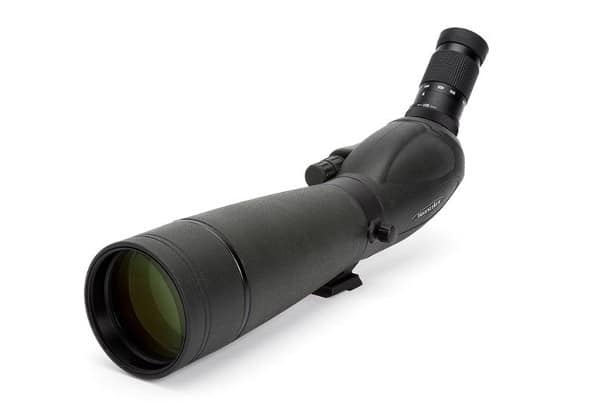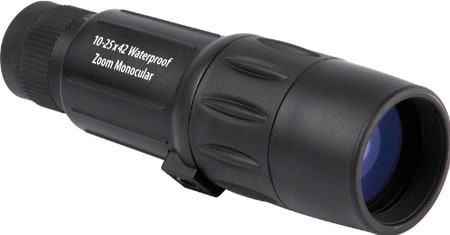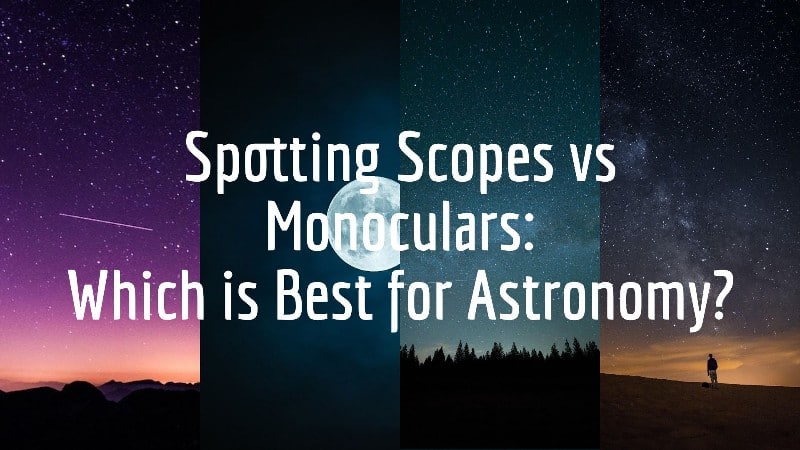Spotting scopes and monoculars can appear fairly similar but there are some key differences to consider.
This can mean that one of these will suit you better than the other depending on what you want to do.
With our expertise on astronomy and astrophotography gear, we have written this guide for you from that perspective, although many of the pros and cons can be applicable for other terrestrial activities like shooting, hunting, and bird-watching.
Read on to understand all you need to know about monoculars vs spotting scopes.
Spotting Scopes and Monoculars
Spotting scopes and monoculars are similar in that they both feature a single tube, lens and eyepiece.
However there are key differences between them that will influence what is right for you depending on what you want to use them for.
Let’s examine first what monoculars and spotting scopes are, before summarizing the main differences.
Spotting Scopes

A spotting scope is a small, compact optical device that uses a glass lens to allow you to see far-off objects through an eyepiece. They are used on tripods and not by hand.
They are generally used for daytime terrestrial purposes like bird watching, ocean-viewing, or shooting, but there are a number of models that are specialized for stargazing.
See the Best Spotting Scopes for Astronomy for the best models.
They can be either:
- Angled – with the eyepiece at a 45-degree angle
- Straight – with the eyepiece straight
Monoculars

Similarly, a monocular is a small, compact optical device that uses a glass lens to allow you to see far-off objects through an eyepiece.
They are handheld devices and are generally not used with tripods.
The purpose is to give you a degree of optical power but in a small device that can be held in your hand.
See the Best Monoculars for Stargazing for recommended models.
Now let’s look at further differences.
Differences Between Spotting Scopes and Monocular
The key differences between monoculars and spotting scopes are:
- Size: Spotting scopes are bigger and usually need to be used with a tripod. Monoculars are smaller and can be used by hand.
- Magnification: Spotting scopes usually have a high magnification of at least 30x and up to 100x. Monoculars usually have a lower magnification of around 8x or 10x.
- Field of view: Spotting scopes have a narrower field of view due to the higher magnification. Monoculars have a wider field of view due to the lower magnification.
- Variable vs fixed: Spotting scopes usually have a variable, zoom magnification. Monoculars usually have a fixed magnification.
- Eyepieces: Spotting scopes can have different eyepieces fitted that can be bought separately. Monoculars have a single built-in eyepiece that cannot be changed. This means that some spotting scopes can utilize astronomy eyepieces and filters.
- Tripod vs handheld: Due to the size and higher magnification, spotting scopes need to be used with a tripod and have a tripod adapter built in. Monoculars are lighter and have a lower magnification that is tailored for handheld use.
- Aperture: Spotting scopes will usually have a larger lens which means a higher aperture of 60mm to 127mm. The smaller size of monoculars means that the aperture is limited to 12mm to 50mm.
- Eye relief: Spotting scopes will often have adjustable eye relief, meaning that you can rest your eye against it, rather than hold it a small distance away. Monoculars do not usually have this, rather they may have a rubber component around the eyepiece that can be folded up or down to provide some degree of eye relief adjustment.
- Price: Monoculars are cheaper than spotting scopes due to the smaller lenses and fewer components.
Note, none of these factors is 100% as there are examples of monoculars larger than spotting scopes, or more expensive, etc.
This video gives a good overview of the key differences and similarities between monoculars and spotting scopes from a terrestrial (i.e. non-astronomy) perspective:
Spotting Scopes vs Monoculars for Astronomy, Stargazing and Astrophotography
Overall, spotting scopes are better for astronomy and astrophotography, but monoculars are better for stargazing.
What do we mean by this?
Spotting scopes are better for astronomy and astrophotography because:
- The higher magnification means they are better for zooming into astronomical objects like planets, moons, or deep sky objects, just like a telescope. This is what we mean by astronomy.
- The higher aperture means that these views will be brighter and clearer.
- However, the high magnification results in a narrower field of view which is not good for scanning the skies to view events like meteor showers. This is what we mean by stargazing.
- Spotting scopes used with a tripod are also the best option for astrophotography. This is most often done with a smart phone, but some models have the capacity to attach a DSLR or mirrorless camera.
Monoculars are better for stargazing because:
- They generally have low magnification and can be used by hand. They can therefore be better than spotting scopes for scanning the skies and watching astronomical events like meteor showers.
- They generally have lower apertures and so will provide less bright and clear views of specific astronomical objects and so will be less suited to astronomy.
- The handheld nature of monoculars is not suited to astrophotography (or any photography) although there are some higher magnification and aperture models that come with mini tripods and smartphone adapters to take photos (see here).
Verdict: Monocular vs Spotting Scope for Astronomy
Overall, it depends on what you want to do for whether a spotting scope or monocular is better for you:
Spotting scopes:
- Generally have higher magnification and larger aperture. The larger aperture will give you clearer views and the higher magnification will allow you to zoom into planets and other astronomical objects (i.e. astronomy).
- However, high magnification is not good for scanning the skies (i.e. stargazing) as it results in a narrower field of view.
- Spotting scopes are more expensive and need to be used with a tripod.
Monoculars:
- Generally have low magnification and can be used by hand. They can therefore be better than spotting scopes for scanning the skies and watching astronomical events like meteor showers.
- But they generally have lower aperture and so will provide less bright and clear views of objects in the night sky.
- They are smaller and much more portable. They can even fit in your pocket and so suit use when you don’t want to carry a spotting scope (or binoculars or telescope) and all the accompanying gear.
- Monoculars are cheaper than spotting scopes.
See the links below for the best spotting scopes and monoculars to buy and for other related content.
Related articles:



